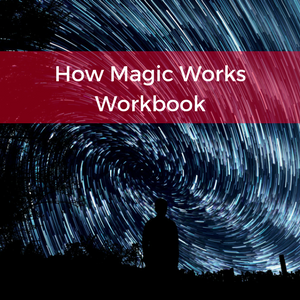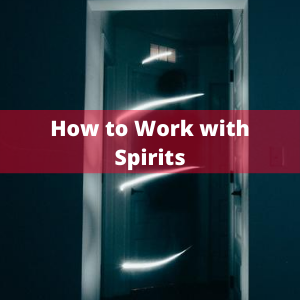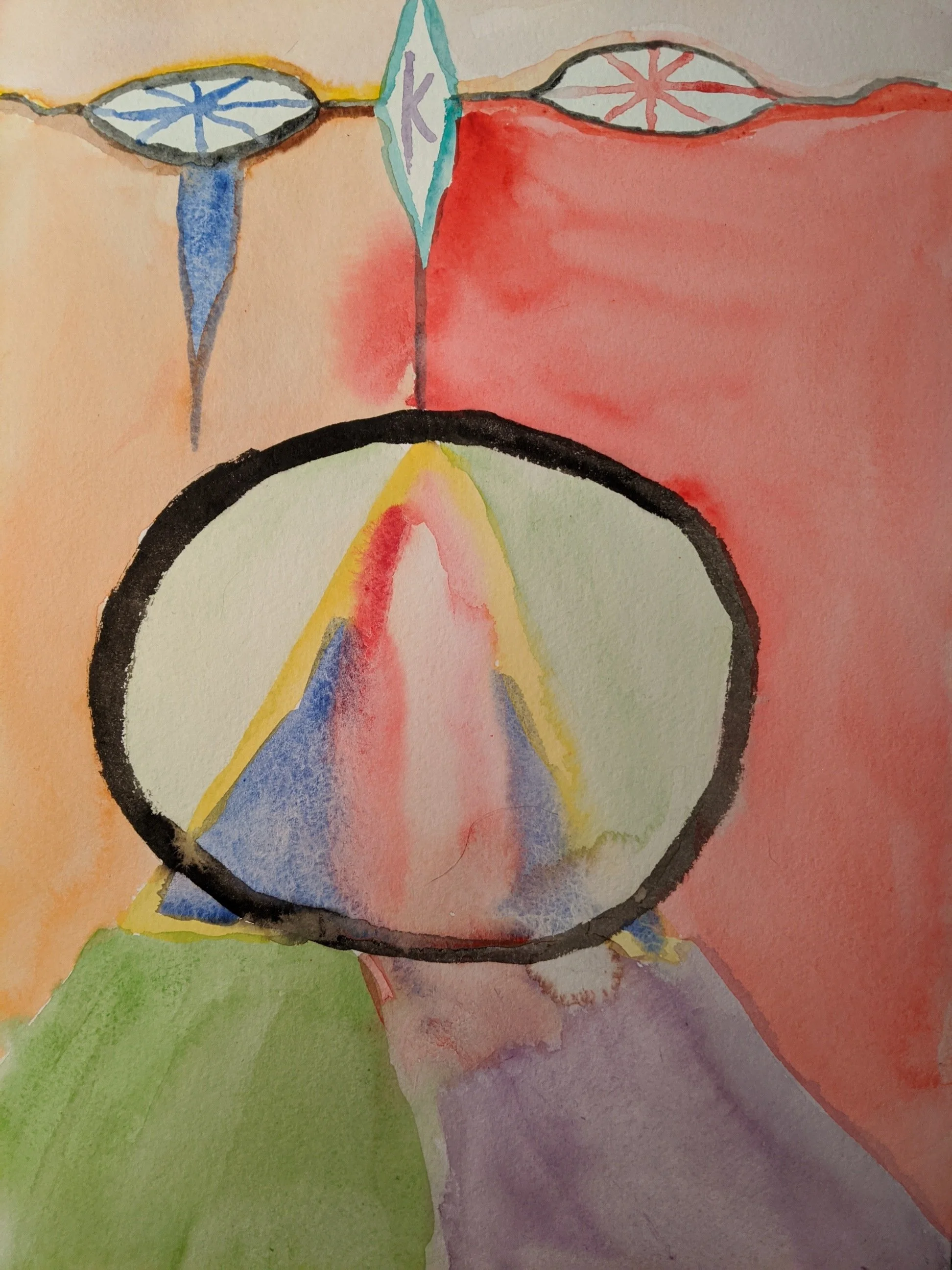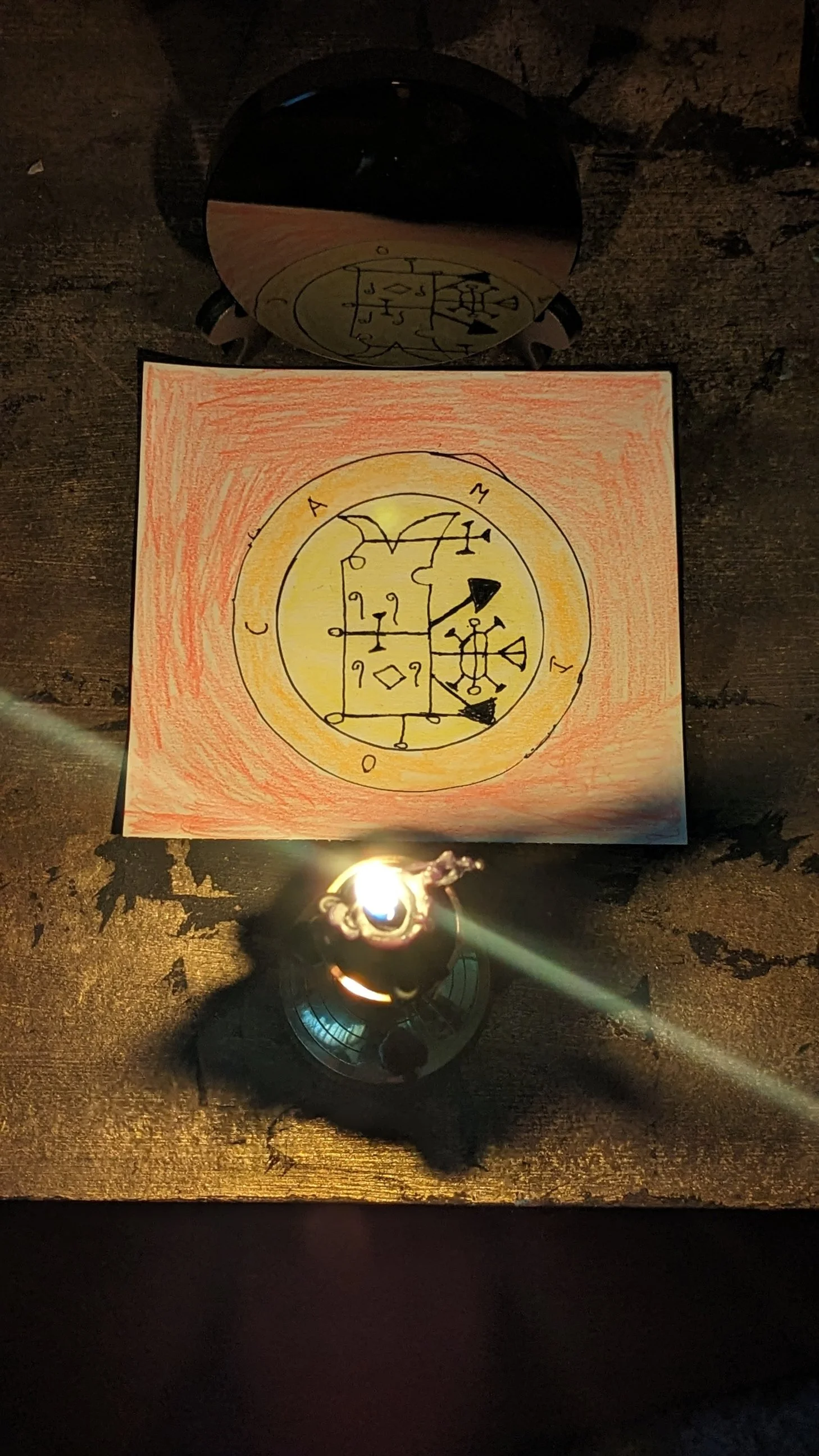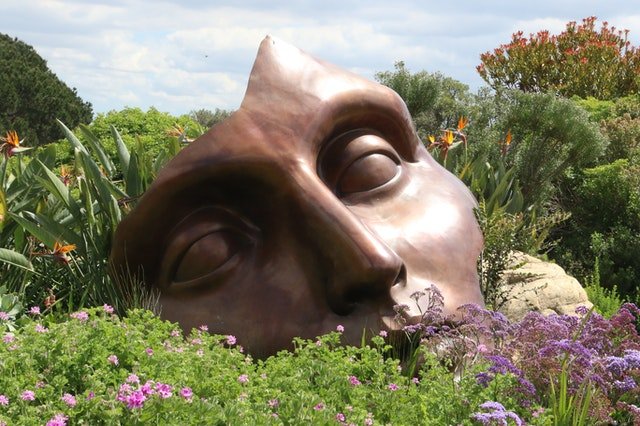Every so often I get requests where a person asks me to help them obtain special powers through magic. In this episode of the magical experiments podcast I lay down the hard truth that there are no short cuts in magic and life and share some of my experiences and stories learning this truth. You’ll also learn why experience is the best teacher and how to let go of unrealistic expectations.
What's underneath the Squiggle: An Exploration of Sigils
picture copyright Taylor Ellwood 2024
Lately I’ve been finding myself fascinating by sigils and symbols again. Whether you’re conjuring a spirit with a sigil or creating a custom sigil for the purposes of manifesting a desire into reality, what makes sigils so versatile is how they can symbolically represent and mediate specific transmissions of information. Yet what’s underneath the sigil?
What’s underneath is something the sigil can’t quite describe or represent. The sigil presents a face to the world that allows us to make sense of the intangible and give it a form we can relate to. It allows us to pack ideas and concepts into the shape and recall them and it allows us to send them out into the world, to create a path of manifestation that turns essence into form and imagination into reality.
Yet a sigil is more even than that. It is a structure that creates a container to describe the essence that is being worked with, whether that’s a spirit’s essence or the essence of a desired result. The sigil becomes a key to unlock that essence and also learn the essence and make it part of your being. The symbol internalizes the essence within you and it becomes manifest through you.
The reason sigils work so well is become of how they work through us. The sigils embed themselves in our consciousness which in turn is acted upon through our actions. It’s a chain of manifestation that acts on the path of least resistance. The sigils, as symbols, are accepted more readily by our consciousness and seed the mind with possibility which then becomes reality, by the convergence of the outer variables of the world and the inner actions of the person.
The sigil is a story as well. We can get to the heart of the story by meditating on the sigil. If the sigil is for the spirit then it becomes path to the spirit that allows the practitioner to interface with the story. If the sigil is for a possibility it speaks to all the variables of the possibility. What’s underneath the squiggle? A universe waiting to be explored.
Why Subjectivity is important in magic
In Holy Daimon by Frater Acher (affiliate link) the author makes an insightful point when he notes the following, “While objectivity is certainly necessary in, for instance, medicine and some fields of physics, it causes real problems when it is applied to all modes of human enquiry.” I agree with his point about objectivity because objectivity is often held up as a holy grail for all methods of inquiry to aspire to, but this isn’t realistic, because not all methods of inquiry can be rooted in objective study. Magic is one such method of inquiry, and with magic it is better suited to ask the questions, “Does it work?” or “Am I getting results?” then to focus on finding objective proof of magic.
These are subjective questions and subjectivity is often treated as less than reliable because it becomes more personal, and the question of proof arises. Can you prove that X helped really happened because of Y? is a question that may naturally arise from a skeptical person. My answer has always been to look at the overall consistency of magic in my life and note through observation whether there are repeatable patterns. Yet, there are also situations where I do magic for a specific situation or to have a specific experience and I may never need to do that magical working again. Even then, what I look to is the overall efficacy of the magical work.
Has this work changed my life? Am I moving in a direction that I want to go toward? Am I having meaningful, life changing experiences? These are the questions I am interested in answering, as well as the inevitable question, Can I experiment with this idea and this process and get a result. I’m less interested in proving that magic is objectively real. I think the evidence for that question is already present by the fact that magic, in one form or another, continues to be a prevalent part of humanity.
Subjectivity is important in magic because it allows us to make room to explore the intersection between out human consciousness and the liminal aspects of reality that don’t fit neatly into conveniently labeled categories that are thrust upon us by people craving certainty, instead of embracing the uncertainty that is life. Subjectivity allows us to be present with the unknown and consider alternate ways of knowing that can bring as much value to us as objectivity can.
A person on the magical path ought to recognize as well that the path IS highly personal. None of us will walk exactly the same path, nor do we need to. Subjectivity helps us recognize this reality of magic and embrace it. My experience isn’t the same as yours and it doesn’t need to be. At the same time, it IS good to apply some rigor to the work. Making fantastical claims without backing those claims up just makes the work harder for all of us, but if you can apply some rigor to your experiences you’ll find consistent patterns in your work that speaks to the questions I mentioned above. Embrace your subjective experience and also track it!
Psychology and Religion and their role in Spirit Work
I recently finished reading Joseph Lisiewski’s Howlings from the Pit (Affiliate link), which is a collection of essays about grimoire magic and of curse his particular argument as to why you have to do spirit work with daemons in a specific way. I don’t agree with Lisieswki’s approach and I’ve gotten efficacious results through my own system of spirit work, but I do think he makes some interesting points that are worth considering, both in regards to spirit work and magical work in general.
Point 1: You have to honor the original religious/spiritual belief system you were raised with - Lisiewski makes the argument that if you were raised in a different religious/spiritual system than the current religfious/spiritual system you are in, and you want to do spirit work, you have to honor original religious/spiritual system at least once or twice a year. I disagree with the author on this limited belief and think it speaks more to his religious/spiritual issues than being an actual and effective axiom.
I was raised episcopalian and was a born again Christian for a time and I never found that I needed to go to a sermon or make some kind of offering at a church in order to do effective spirit work. When a person makes a rule or axiom around any magical work, we ought to carefully consider the subjective nature of such rules. What works for one person may not work for another and may not even be relevant.
Point 2: If you put your power in magical tools this takes away from the power you bring to rituals. - This is an interesting argument that I find myself agreeing with in some ways. Lisiewski is specifically referring to the creation of tools for the Golden Dawn rituals and how part of that process involves embedding your personal energy within those tools, which ends up taking away from the efficacy of your work with other magical systems.
I do think its possible to invest a lot of yourself into a given magical tool, which is one reason I recommend not relying on any given magical tool too much. A magical tool is meant to be an aid and representation of something you are working with. It can help you access certain frames of mind and being, but it should never be something you rely upon so much that you can’t do anything without it.
Point 3: If you don’t do the magical working the right way, you can suffer adverse effects (aka his slingshot method). I don’t think there’s a right or wrong way to do magic, but you can definitely tell if a given process or methodology is working by the results that are being generated with that process. Keeping careful track of the results, consequences, and adverse effects that come with magical work is a good idea because it helps you recognize what is working or what can be improved upon.
Sometimes you will experience adverse effects with magical work. These may show up as synchronicities indicating the confluence of possibilities lining up to manifest the result or spiritual forces showing up to help or hinder the work involved. The key is not read too much into anything, and continue doing the work until you’ve finished the operation.
Point 4: Your psychological, spiritual, ideological values play a role in your magical work. This point is a bit similar to point 1, but also distinct. What we believe and think about ourselves, other people, and the world around us plays a role in the magical work we do. It’s important to acknowledge the internal reality and the role it plays in our magical work. In my own experience the majority of the time a magical working doesn’t work is because of the internal reality of a person and what is out of alignment with that internal reality and the desired result the person is going for.
Point 5: You have to do specific activities at specific times with specific items. Ironically, one of the points the author made in contradiction to point 2 was that you need to use certain items at certain times in order to get results. I won’t argue that a given system of magic may speak to specific necessities around magical tools, times, etc., but what I find personally powerful about magic is that you can come up with your own systems and processes and get results that are consistent and powerful. You can also do this with a pre-existing system, but you do operate within the constraints of that system. Either way can work, but its important to figure out what works for you. The beauty of magic is that it provides a versatility that can be explored and experimented with, provided we’re willing to question the underlying narrative that magic has to be done a specific way in order to be effective.
The form and the essence of magical work
I was recently reading Howlings from the Pit by Joseph Lisiewski and I was struck by something he wrote in regards to ceremonial magicians creating magical tools that took away from the actual experience and success of magic they worked. What struck me is that the magicians were giving up the essence in favor of the form, when in fact they ought to take the opposite approach and give up the form to understand and work with the essence.
Being the magical nerd that I am also made me think of a scene in God of War Ragnarok where Brok the Dwarf tells Kratos that to create the form you have to find the essence. The essence is the key to the form. The form doesn’t exist without the essence. It made me consider Lisiewski’s perspective from another angle: How much of the essence do we give to the form, which in turn causes the form to have the power, presence, magick, etc that would otherwise stay with the essence?
In my own magical work, I’ve typically taken a minimalistic approach to my magic and spirit work operations. I have sometimes added some effects because I recognized that those effects would enhance the overall work, but even with the inclusion of those effects the question I always ask is: Does this help me connect with the magic/spirit more effectively? This is the question that any magician ought to ask themselves in order to best understand how magic can work.
What helps me get to the essence of the work? Is the form a distraction or does it actually help me truly connect with what I want to work with? These are additional questions that are useful to ask. I personally would never take the approach that Lisiewski takes, which is grimoire based because I find that form distracts from the essence. My form, developed and personalized to help me with both magical and spiritual work allows me to connect with the essence of the work I am doing…but Lisieswki would have similar issues, in no small part because of his adherence to his own system of magic and the limitations he operates in.
A given system of magic has its specific rules and limitations. If we recognize this we can see past the form to the essence and focus on working with the essence to help us achieve the ideal form we planned for. We naturally want to attend to the details of a magical working but part of attending to those details is taking the time to understand how the form magic takes actually allows us to connect with the essence and what that means as a result of the work we do.
The Role of Boundaries in Spirit Communication
When we don’t establish the right kind of container with the proper boundaries, spirit communication and work can become problematic. I discuss the importance of setting clear boundaries in your magical work and share why this can benefit you.
If you want to learn more about my upcoming class Advanced Spirit Communication, go here.
5 common misperceptions about communicating with spirits
One of the questions I see frequently asked by other practitioners is how to test and verify if a spirit is on the up and up as it were with the information it provides. Another question I see asked is whether anyone has ever seen a spirit manifest in physical form. These types of questions are valid ones to ask but what they often indicate to me is that the person is caught up in surface level details and is missing out on the subtleties of spirit communication. This brings me to the topic of this article…
5 Common Misperceptions about Communicating with Spirits
The first misperception that many practitioners have around communicating with spirits is an expectation that spirits will communicate using the verbal language you are used to hearing. Naturally we want spirits to communicate with us in the language that we are used to using every day and some spirits may choose to do that, but more often than not I have found that spirits communicate in much more subtle ways, and through what I would consider to be a transmission of information, which acts as a download. Spoken and written language, in comparison are very limiting.
The second misperception is the expectation that spirits will appear in a physical form that you can see. This is one of those tropes of modern occultism where there’s a perceived value in a spirit manifesting physically even though said manifestation doesn’t accomplish much if anything meaningful. I’ve never had a spirit manifest in a physical form yet I’ve had efficacious workings with the spirits. The need for a physical manifestation is a vanity and ego play in occultism which keeps the practitioner from accomplishing real work with the spirit.
The third misperception is the expectation that spirits have the same types of desires and needs that we have. This is reflective of a tendency to humanize spirits. We do this because we want to ascribe motivations and desires to the spirits that we can understand, but these motivations and desires are out of alignment with the nature of a spirit. A spirit may have desires and needs, but those desires and needs are based in the experience that spirit has, which is significantly different from our everyday experience.
The fourth misperception is a tendency to focus on specific aspects of what a spirit can do or provide without considering the bigger picture. This misperception is rooted around the tendency to focus on specific aspects of a spirit, such as its elemental correspondence or domain of influence, because you want the spirit to do something specific for you. It cherry picks the spirit for what is convenient for you and ignores other aspects that either might be helpful or detrimental…or may cause you to ignore other possible spirits to work with.
The fifth and final misperception is around the understanding of power and potential versus form and manifestation. Spirits don’t have the same material awareness or form that we have, but they have access to more power and through it potential. What they provide is possibility and influence which can be directed to help manifest a result, but we bring something essential to the equation as well. We bring the ability to manifest potential into reality through our material and manifest form. If you want to turn a possibility into reality you necessarily sacrifice power for manifestation.
If you want better communication with spirits, where you get consistent results that transform your life then you’ll want to sign up for the Spirit Communication class, where I’ll share my tried and true techniques for connecting with spirits.
Why do people want to communicate with spirits?
The rules of Spirit Summoning
Photo by Farzad Sedaghat: https://www.pexels.com/photo/mysterious-shadow-behind-dark-backdrop-3809379/
Lately I’ve been reading books on how to work with Daimonic spirits, as research for my next book in the walking with spirit series. One of the subjects I find fascinating about the books is the rules that the authors provide for summoning spirits. From what I can tell most of these rules are arbitrary rules, personalized to the theories and ideas that writers come up with as a way of explaining how to safely call forth the spirits. While there is some consistency in regards to utilizing angels to help in the process of summoning the spirit, the process itself seems to vary from purely psychological and symbolic workings to elaborate ceremonial and ritual magic.
The question that arises in my mind is how much any of these rules are essential and how much of them are arbitrary, based on cultural and religious assumptions and modalities that create a narrow and limited perspective of what it means to work with a spirit. When we step outside the Western informed framework of spirit work what is discovered is a multiplicity of perspectives on working with spirits, all of which provide valuable insights and perspectives about how to work with spirits without necessarily employing everything that is brought into play with the Western model of spirit work.
One of the assumptions that we ought to question carefully is what we believe about spirits versus what we know about them versus what we are told about them. Take a piece of paper and write down what you believe, what you know, and what you have been told. Where did each of these perspectives come from in your life? What informs your beliefs, the facts, and your experiences?
And here’s another perspective to consider? What did your ancestors believe about spirits? You may be able to ask your parents or grandparents directly, but go back further. What did your ancestors a century, or two centuries or further back think or believe about spirits?
How Correspondences Work
In this video I talk about correspondence tables and what the real purpose of correspondences is and how this can help you with your magical work.
Inner Alchemy of Life: Physiological Magic pt 2
In part 2 of Physiological Magic I share how I gradually evolved my system of physiological magic and discuss the thought process and methodology involved in the evolution of that system, as well as how this enabled better communication with the neurotransmitters and hormones.
Walking with Nature Spirits is now Available!
In Walking with Nature Spirits I share how to develop a collaborative relationship with nature spirits and nature in order to create a rooted and embodied life.
Nature spirits are unlike any other kind of spirit you can work with. They don’t care about making pacts or bargains. Their focus is on taking care of nature and if you want to work with them you have to shift your approach to spirit work in a way that will seem radical and yet can help you develop a deeper relationship with the world around you. In this book you will also learn the following:
How to meet and recognize the spirit and character of the land and communicate with it.
How to identify power spots and ley lines and form a bond with them.
How to work with the land you live on and make it into a place of power.
How to use all of your senses, psychic and physical to work with nature spirits.
and much more!
If you’re ready to develop a deeper relationship with nature and nature spirits, this book will teach you a new approach to working with nature that will help you develop bond with the land.
Inner Alchemy of Life: Physiological Magic pt 1
I discuss my systems of physiological magic and share how I came up with it and provide the basics of how it works in relationship to treating neurotransmitters and hormones like spirits.
How to Fuel your Magical Entities and get better results
Picture copyright Taylor Ellwood 2023
Recently I was asked a question about how I fuel magical entities. The person asked if I relied upon deities, elemental or planetary currents or other traditional forms of fueling that are typically used with magical entities. It's a good question to ask, because there are many different ways you can set an entity up, both in terms of how you fuel it, and in terms of other specifications and customizations you can make to the entity.
While I can and do draw on more traditional methods for fueling entities, these methods are only one part of my process for fueling entities (or doing any other kind of magical work that requires a fuel source). The benefit of drawing on more traditional sources is that they are tried and true. For example if you create an entity that's focused around love, it makes sense that you might draw on the Venusian current or seek the aid of a love deity to help you with empowering the entity to perform it's specific tasks.
On the other hand, one might rightfully ask why not just go directly to the source and work with the love deity or the planetary energy without drawing upon an entity for the purposes of doing the spiritual work? Certainly that's a good question to ask as well.
The reason I choose to work with a magical entity is because I can tailor the entity toward the specific needs of the situation, which can be useful, especially if the situation doesn't exactly fit within the domain of a given spirit's influence. Another reason I might create an entity is because I want some distance from the situation, but I still want a magical working to be done, but through a lens that focuses in on my understanding of the situation. A deity or more traditional spirit may not have the exact understanding of the situation that an entity can be programmed to have...and that can be very useful with specific examples.
Sensory over stimulation and scrying
Image courtesy of Taylor Ellwood 2023
I've been continuing to experiment with scrying using a combination of tools for the purposes of overstimulation. For this particular process I've been working with Andras and Haures, two of the daemons from the Goetia. The initial process has involved setting the sigil for the given daemon up so its between a candle and the black mirror I have set up. I evoke the daemon using the enn for it and then stare at the at the mirror through the candle flame...but set up an optical illusion so that it seems like the candle is doubled in appearance.
I also have been filming these sessions live on instagram and I have the camera propped up so its directed at the flame. The camera creates a halo effect with the flame which can also be used for scrying purposes. I use it as an additional layer of sensory overstimulation. I'm chanting the enn, looking at the candle and mirror and then sometimes scrying via the instagram live video.
Further Scrying Experiments
I took a little break from my scrying experiments because of a weekend trip I took where I did a lot of intense shadow work. I knew I needed to make time to integrate that work back into myself and that doing scrying work on top of that work wasn't a good idea.
But on Saturday night I decided I as ready to start the scrying experiments up again. This time I chose to work with Goetic Daemon Andras, around helping me release and let go of some fear I'd been feeling and to help me also get to the core of that fear.
I chose to evoke Andras via a candle and the black mirror. I also recorded a video of the scrying via Instagram, in part to set up the phone recording as another version of the scrying. What I've noticed is that when I record the scrying, it actually creates an intriguing effect with the candle, where the light of the candle creates a sphere of light in the recording that can also be used for scrying.
What makes a spirit a spirit?
Image courtesy of pexels
I've been thinking about the question, "What makes a spirit, a spirit?"
I'm currently writing Walking with Nature Spirits, and in the writing of this book I've been thinking about this question because of how I approach the work with nature spirits, but also because of the stereotypical imagery associated with nature spirits, which usually has them set up with imagery of gnomes, undines, slyphs, etc., basically humancentric shapes and appearances. The benefit of the humancentric shapes is that it makes easy for us to identify with those spirits. The downside however is that we all too often get stuck filtering our experience of a given spirit on the basis of the human oriented shape we associate with it. This isn't limited to nature or elemental spirits either.
We see this same tendency to humanize the appearance and experience of spirits with Daemonic spirits, angelic spirits, and any other type of spirit out there. This tendency brings with it a kind of entitlement as well: Namely the entitlement that the spirits are really here to serve or work for us. It's a naïve belief that isn't fully accurate and can create potential problems when we adhere too strongly to notions of what we think spirits are or are not.
One of my main purposes for writing the Walking with Spirits series is to present an alternate perspective to spirit work that is rooted in building a collaborative relationship with the spirits, but also recognizes that to experience the spirits we must be willing to experience them on their terms as much as possible.
What does that look like?
Scrying for spirit Communication
Picture copyright Taylor Ellwood 2023
One of the ways I like to work with scrying is with spirit communication.
I already have a strong connection to spirits, having always had a natural proclivity toward communicating with them, but what I'm finding with scrying is that this proclivity is further enhanced when working with the right tools.
In my case, the right tools are a combination of candles and black mirror, along with sometimes using additional tools including a pendulum, Tarot, or cowrie shells for divinatory purposes.
I'll also work with specific spirits around specific themes or areas of interest. In the picture above I have a sigil for the goetic spirit Camio that I'm working with for the purposes of enhancing my skills with candle magic and scrying through flame work.
The relationship between sacred kingship and the land
One of the books I’m reading lately is King, Warrior, Magician, Lover by Robert Moore and Doug Gillette. It’s a fascinating book that explores the archetypes of the mature and sacred masculine. This is currently part of the spiritual work that I’m engaged in as I explore my own relationship with masculinity and heal the ancestoral and contemporary wounds that I’m becoming aware of as it relates to how masculinity is treated and perceived in modern times.
One of the aspects I’m exploring in particular is related to sacred kingship and the land. I am in the process of exploring the new city and surrounding areas that I live in. While I’ve lived here for a year, I didn’t have much opportunity until recently to really begin exploring the area and developing a relationship with the land. I find it fitting and useful that part of the process has also involved cultivating a relationship with the land, particularly on the basis of the relationship has with their home and how that relationship plays out in sacromagical work one does in connecting with the land.
The wild man and the sacred masculine
I’ve recently been reading a book called Iron John, which is a fascinating exploration of the Wild Man and the journey of a boy to discover sacred masculinity, through the wild man, as well as the sacred connection between the land and the spiritual king. I’m only halfway through the book at the time of this writing, but what strikes me about this book is a theme of journeys, and specifically the journey the boy is initiated through when he chooses to free the wild man (Iron John) from the cage he is in, and goes with him to the wilderness.
It reminds me of the Green Knight and the journey Gawain goes on to return the axe to the Green Knight as well as offer his head. All the experiences Gawain has along the way are part of an initiation into the mystery of the sacred masculine. When he first leaves on his quest, although Gawain is technically a man, he’s really a boy. He only begins to discover his own masculinity, in a sacred context, when he undergoes the various trials that reveal his weaknesses and failings as well as his strengths.


